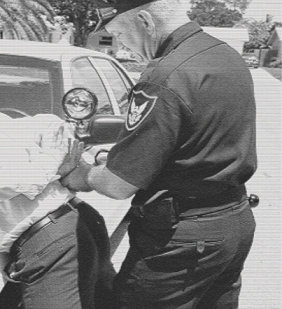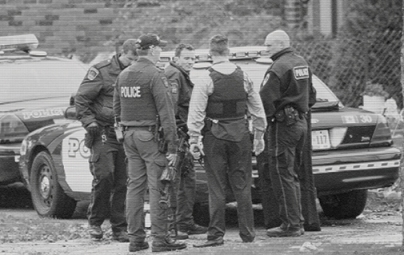Crime Fighter
August 20, 11
Talking to John Kennedy, president of the Jewelers Security Alliance (JSA), the industry’s crime watchdog, makes for a reassuring conversation. While stories of dramatic heists and stings involving the jewelry and diamond industry make the headlines every so often, crime, especially violent crime, is on the decline, as Danielle Max discovers.
According to Kennedy, the most noticeable change over the past decade or so has been the dramatic decline in robberies and thefts of travelling salespeople in the U.S. While he admits that one of the main reasons for the decline is because these days there are fewer sales people on the road, he also cites an increased focus on the problem by the FBI and other law enforcement agencies.
Traveler numbers have dropped as a result of both the economic slowdown of the past few years and an increase in other channels of distribution, such as trade shows and online sales that makes travelling salespeople redundant to some companies.
While there may be fewer people on the road, Kennedy says that owing to greater efforts by the law enforcement agencies, especially the FBI, the number of hits on traveling salespeople has dropped by about two-thirds compared to 10 years ago. “The FBI has several task forces in their units around the country that pursue those criminals that attack salespeople,” he explains. “Almost all of them are South Americans, especially Colombians, who are in the country illegally.”
 |
The FBI has been especially vigilant in reducing their numbers. It has arrested many of them and has deterred many others from getting involved in that type of crime. “In every country there are certain ethnic groups that concentrate on certain types of crime,” says Kennedy. “While you don’t have to be a rocket scientist to carry out this type of crime, for some reason, no other group concentrates on jewelry crime of this nature. I can only cross my fingers and hope they don’t.”
Another change for the better, sort of, is that when jewelers and salespeople are being targeted, both on the road and in store, the incident is less likely to involve a gun. Instead, says Kennedy, there has been an upsurge in the number of confrontations involving knives, other sharp weapons or even just fists. The reason for this turnaround is that Federal rules mandate that if a gun is used in a robbery, it increases the seriousness of the crime, which leads to harsher sentencing if a criminal case is conducted. This does not mean, however, says Kennedy that guns are not around, but they are less likely to be used in the actual incident. “If the criminals are chased or followed, they will use weapons,” he says.
While crime is on the decline in the U.S. in general, and has been on a downward spiral for some 20 years or so, jewelry crime in general, not just that involving travelling salespeople and jewelers, has actually dropped even more sharply. “While homicide might be off, say 20-30 percent in the last 10 years, in the jewelry industry, we used to have 15 deaths a year, and now we have only two or three,” says Kennedy.
As well as the increased activity on the part of the law enforcement agencies, another factor in reducing jewelry-related crime is the increase in the amount of information that jewelers themselves are sharing with each other.
One of the main activities of the JSA is a weekly email alert sent to its members detailing the latest crimes, warning of scams and issuing photographs of suspects. In addition, the organization, along with the Jewelers Mutual Insurance company and Jewelers of America, helped launch the Local Crime Prevention Network Project. Through this system, jewelers can share information with other jewelers in their network, as well as work closely with local police on crime prevention issues.
This set-up, says Kennedy, has become a very powerful tool in a lot of communities. “There are about 68 networks in this country that share information and that work with their local police on jewelry crime issues. This kind of awareness improves jewelers’ knowledge base and makes them more careful. Being more informed has an effect on reducing crime,” he says.
While many jewelers are becoming increasingly more aware of what they have to do to reduce crime, there are still those who do not comprehend that they can be targeted and are all too often making very basic mistakes that are putting themselves, and their inventories, at risk.
Lately, there has been an increase in the number of rooftop burglaries, and other types of break ins. Jewelers, says Kennedy, have to realize that they need an alarm system that covers their entire premises because burglars are able to infiltrate their premises in many different ways. In addition, he says, they should ensure they have line security so that if the alarm system is interfered with, it will still send a signal, indicating a problem rather than simply going dead.
Once the alarm system is dealt with, jewelers should take a look at their safes to make sure that they are able to withstand determined thieves. “The safes that were viewed as okay in the past are not adequate any more. The tools that they burglars have these days can cut into many safes that are currently being used,” says Kennedy.
When it comes to the more low-tech type of thefts, the grab and runs, Kennedy explains that just by exerting greater prudence, jewelers could see many of these types of incidents reduced. “We see people displaying large amounts of product to people at one time; taking out a whole tray of rings to show to someone who just grabs them and runs away. You have to be a little more cautious. Showing one ring at a time is our advice when you show more than that, you start getting into trouble.”
 |
This advice is especially relevant to people who are properly insured, and should ring warning bells to those who are under insured, or not insured at all (Kennedy estimates that a very small percentage of jewelers may have dropped their insurance coverage as a result of the economic downturn). While stating that he does not have any hard and fast statistics to back up his impression, Kennedy says that jewelers who are uninsured are more likely to have a gun and to try to fight back if there is an incident in the store. Consequently, they are more likely to get hurt. “We encourage people to rely on their insurance,” he says. “Don’t go chasing after the guy and refuse to comply with his wishes or demands,” he urges.
He also has good advice for staffing a booth. “At a trade show, it is hard to control goods at the booth. If there are too many customers, which is a good thing, you are overwhelmed and you grow frazzled and careless. Make sure you have enough people working on the booth to maintain a controlled situation. If you don’t have enough people, hire a guard.”
Kennedy also has general advice for people travelling both to trade shows and on other trips. “A travelling jeweler always has to be careful to check if he or she is being pursued. You always have to be careful to take steps to determine if anyone is following you and seek help if you think you think you are being targeted,” he says. “It doesn’t matter where in the world you are; you have to take the same security procedures and precautions everywhere.”
In terms of travelling salespeople and jewelers, he urges them to be very watchful since criminals will frequent jewelry locations and follow people away from them. “They are going to follow you from a jewelry premise. That’s how they target you.” He says jewelers should engage in evasive driving techniques as a means of ensuring they are not being followed. “Drive slow, drive fast, pull into a store, pull out again, do everything to make sure you are not being followed.”
Finally, he urges jewelers and diamantaires to be very careful in sharing information through social media networks. “They should be very, very cautious about what they put online. They should never share personal information online about their home, their family and especially not about their travel plans.”
Good advice, simple to implement, but it could very well be lifesaving.